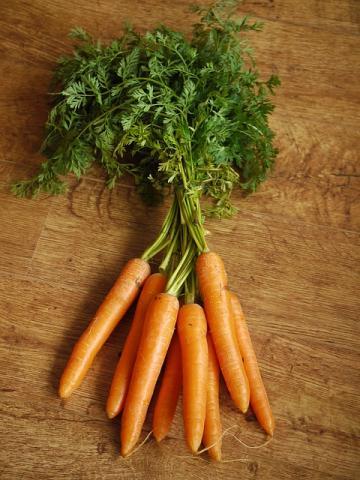
It’s easy to focus on those plump, crunchy parts of root vegetables, but who knew that the foliage above ground, responsible for all the goodness that grows below, is just as nutritious? I’m talking about your carrots, beets, and even those radishes that you may – hopefully – purchase with the tops flopping around awkwardly. Don’t be fooled! Those tops are a goldmine of nutrients including iron, magnesium, potassium, calcium, folate, and vitamins A, B, C, E and K. Another top that is often overlooked (and, I’d argue, almost better than it’s bottom!) is the garlic scape, which is essentially the flower of the garlic plant harvested before the flower blooms. Be sure to capitalize on the vitamins and nutrients overflowing in these four fresh vegetable tops!
- Carrot greens
These feathery tops actually taste quite like the carrot bottom. They contain six times the amount of vitamin C found in the carrot! Rich in protein, and also a good source of calcium and potassium, carrot greens can be used to make a nice variation of pesto. The stiff stalk part is a bit fibrous and stringy (like celery), but the soft leafy parts can be tossed into smoothies, juices, or in a salad or other dish, similar to the way you might use parsley.
- Beet greens
The tops of beets resemble the texture of swiss chard, but are milder in taste. They are best harvested when they are young, and therefore tenderer. Beet greens contain vitamins A, C, E, K and some B, in addition to minerals such as calcium, iron, magnesium, and potassium, among others. Beet greens are easy to chop and sauté in the same way you may use chard, spinach, or mustard greens (another top to watch out for). Beet greens can also add extra nutrients to a fruit smoothie without altering the flavor tremendously.
- Radish greens
It can sometimes be difficult to find radish tops – or any of these green tops, for that matter – at the grocery store. Unlike the spicy radish, the greens are milder and less bitter. Their moderately “fuzzy” nature may tickle some wrong, but like carrot greens, radish greens also contain six times the amount of vitamin C found in their ruby root! Also a good source of iron, calcium, and potassium, these tops can be tossed into salads or also sautéed up with other greens to complement.
- Garlic scapes
The garlic scape is the flower stalk that shoots up from the bulb of garlic and winds into 1-3 curls when it is ready to be harvested. The best way to get your hands on garlic scapes is to grow garlic yourself, or to ask around at your local farmer’s market. Garlic scapes are rich in fiber, folate, antioxidants, and vitamin K and provide many of the same health benefits as the garlic bulb. My favorite recipe to make with the less pungent garlic scape is a pesto, and you can also use them raw in salads, add them to stir fries, or chop and sauté for a lighter garlic flavor.
Flat Iron Farm Garlic Scape Pesto
10 whole garlic scapes, rough chopped
1/3 cup olive oil
1/3 cup raw almonds, rough chopped
1/4 cup grated parmesan cheese
salt and pepper to taste
*optional: a dash of maple syrup or agave rounds out the garlic spiciness nicely
In a food processor, combine all of the ingredients, adding more olive oil as needed to reach a smooth consistency. Enjoy with pasta, eggs, toast, dip vegetables, or freeze for later use.








